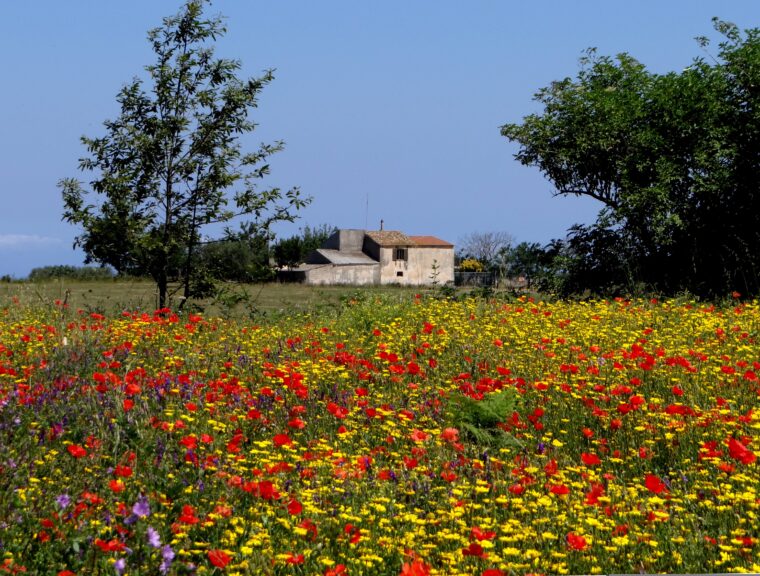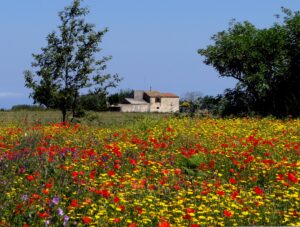
BE A BETTER GARDENER by Thomas Christopher
By Natural Design
I’ll admit to a prejudice when it comes to gardening. I have great respect for what you learn in horticultural schools. I myself am very grateful for all that was taught to me in the Student Horticulturist Program at the New York Botanical Garden. Still, with all the knowledge you get at such an institution, you also tend to absorb, and later take for granted, the attitudes of your teachers. That’s why I am always interested in the practices of self-taught gardeners. Sometimes, lacking the standard answers you are given in school, autodidacts come up with novel and imaginative solutions. For example, there is Benjamin Vogt.
Ben is a poet and a former university professor who became fascinated with gardening as a way to connect with the landscape and natural life in the suburb outside of Lincoln, Nebraska where he and his wife and son now live. That happened in 2007 when Ben and his wife purchased their current home, which was set on a patch of lawn identical to all the other yards up and down the street. Ben, however, turned 2,000 square feet of that turf into a tapestry of native prairie plants. Despite some push-back from neighbors hostile to his “weeds,” Ben persisted, and the distinctive, all-season beauty of his yard attracted a growing fan base. His admirers kept asking Ben for advice and help, and in 2015 he launched Monarch Gardens LLC, a “prairie-inspired design firm” to share what he had learned.
One thing that distinguishes Ben’s work from that of other prairie restorationists is his particularly thoughtful relationship with the flora and fauna. In 2017 he collected these thoughts into a book, “A New Garden Ethic: Cultivating a Defiant Compassion for an Uncertain Future.” Gardening, in Ben’s view, should be far more than just outdoor decoration. Depending on how it is practiced, Ben suggests that it can reconnect us with the wildness we need in our daily lives. Besides, he adds, “Environmentalism” on the part of the gardener, “is not political, it’s an ethical rewiring of our animal brains and social justice for all marginalized species facing extinction.”
Ben’s first book provoked a lot of conversation and brought him requests to speak all over the United States. This spring, he published another, “Prairie Up.” This focuses on the practical aspects of his garden practice, presenting a picture of a very different design process. I found his insights pertinent for virtually any gardener who seeks to turn his, her, or their plot into a functional community of mostly native plants, one that will reinforce the local ecosystem while also spiritually nourishing human inhabitants.
Ben’s style of design involves a very different understanding of how plants grow. The sort of traditional gardening I was taught prescribes allowing each plant all the space it needs to achieve maximum development. That’s the basis of the spacing recommendations you find on nursery labels. As Ben points out, though, in a genuine prairie setting the plants compete for space, jostling with their neighbors. A species that remains robust but relatively compact in the wild is likely to explode in out-sized, floppy growth when gifted by a gardener with all the room, root-run, moisture, and fertilizers it can absorb. Ben’s explanation of this made me realize that this is a dynamic to watch for not only in Midwestern grassland gardens and to Eastern meadows, but also to other sorts of naturalized plantings such as backyard woodlands. After all, to prevent weed invasion without resort to herbicides, it’s essential to fill every niche, every opportunity for growth, in your native garden, and that inevitably brings the plants into competition.
Some competitors, even those native to the region, may be just too aggressive for some situations, such as a small front yard garden. This is why Ben assigns a sociability rating to each species. A plant ranked as a “1” is a well-behaved clumper, and probably wouldn’t long survive juxtaposition with a fast-spreading “4” such as a Canada goldenrod. The 4’s, though, might be just the thing to populate a large field, or to adopt as an ally in crowding out existing invasive species.
The emphasis on insights gained through in-the-garden experience makes Prairie Up an unusually useful guide for any gardener seeking to repopulate their yard with the local natives. The book is available through bookstores and through Ben Vogt’s website: www.monarchgard.com. To listen to my most recent conversation with Ben, listen to the Berkshire Botanical Garden’s “Growing Greener” podcast at www.berkshirebotanical.org.
Be-a-Better-Gardener is a community service of Berkshire Botanical Garden, located in Stockbridge, Mass. Its mission, to provide knowledge of gardening and the environment through a diverse range of classes and programs, informs and inspires thousands of students and visitors each year. Thomas Christopher is a volunteer at Berkshire Botanical Garden and is the author or co-author of more than a dozen books, including Nature into Art and The Gardens of Wave Hill (Timber Press, 2019). He is the 2021 Garden Club of America’s National Medalist for Literature, a distinction reserved to recognize those who have left a profound and lasting impact on issues that are most important to the GCA. Christopher’s companion broadcast to this column, Growing Greener, streams on WESUFM.org, Pacifica Radio and NPR and is available at berkshirebotanical.org/growinggreener.
I’ll admit to a prejudice when it comes to gardening. I have great respect for what you learn in horticultural schools. I myself am very grateful for all that was taught to me in the Student Horticulturist Program at the New York Botanical Garden. Still, with all the knowledge you get at such an institution, you also tend to absorb, and later take for granted, the attitudes of your teachers. That’s why I am always interested in the practices of self-taught gardeners. Sometimes, lacking the standard answers you are given in school, autodidacts come up with novel and imaginative solutions. For example, there is Benjamin Vogt.
Ben is a poet and a former university professor who became fascinated with gardening as a way to connect with the landscape and natural life in the suburb outside of Lincoln, Nebraska where he and his wife and son now live. That happened in 2007 when Ben and his wife purchased their current home, which was set on a patch of lawn identical to all the other yards up and down the street. Ben, however, turned 2,000 square feet of that turf into a tapestry of native prairie plants. Despite some push-back from neighbors hostile to his “weeds,” Ben persisted, and the distinctive, all-season beauty of his yard attracted a growing fan base. His admirers kept asking Ben for advice and help, and in 2015 he launched Monarch Gardens LLC, a “prairie-inspired design firm” to share what he had learned.
One thing that distinguishes Ben’s work from that of other prairie restorationists is his particularly thoughtful relationship with the flora and fauna. In 2017 he collected these thoughts into a book, “A New Garden Ethic: Cultivating a Defiant Compassion for an Uncertain Future.” Gardening, in Ben’s view, should be far more than just outdoor decoration. Depending on how it is practiced, Ben suggests that it can reconnect us with the wildness we need in our daily lives. Besides, he adds, “Environmentalism” on the part of the gardener, “is not political, it’s an ethical rewiring of our animal brains and social justice for all marginalized species facing extinction.”
Ben’s first book provoked a lot of conversation and brought him requests to speak all over the United States. This spring, he published another, “Prairie Up.” This focuses on the practical aspects of his garden practice, presenting a picture of a very different design process. I found his insights pertinent for virtually any gardener who seeks to turn his, her, or their plot into a functional community of mostly native plants, one that will reinforce the local ecosystem while also spiritually nourishing human inhabitants.
Ben’s style of design involves a very different understanding of how plants grow. The sort of traditional gardening I was taught prescribes allowing each plant all the space it needs to achieve maximum development. That’s the basis of the spacing recommendations you find on nursery labels. As Ben points out, though, in a genuine prairie setting the plants compete for space, jostling with their neighbors. A species that remains robust but relatively compact in the wild is likely to explode in out-sized, floppy growth when gifted by a gardener with all the room, root-run, moisture, and fertilizers it can absorb. Ben’s explanation of this made me realize that this is a dynamic to watch for not only in Midwestern grassland gardens and to Eastern meadows, but also to other sorts of naturalized plantings such as backyard woodlands. After all, to prevent weed invasion without resort to herbicides, it’s essential to fill every niche, every opportunity for growth, in your native garden, and that inevitably brings the plants into competition.
Some competitors, even those native to the region, may be just too aggressive for some situations, such as a small front yard garden. This is why Ben assigns a sociability rating to each species. A plant ranked as a “1” is a well-behaved clumper, and probably wouldn’t long survive juxtaposition with a fast-spreading “4” such as a Canada goldenrod. The 4’s, though, might be just the thing to populate a large field, or to adopt as an ally in crowding out existing invasive species.
The emphasis on insights gained through in-the-garden experience makes Prairie Up an unusually useful guide for any gardener seeking to repopulate their yard with the local natives. The book is available through bookstores and through Ben Vogt’s website: www.monarchgard.com. To listen to my most recent conversation with Ben, listen to the Berkshire Botanical Garden’s “Growing Greener” podcast at www.berkshirebotanical.org.
Be-a-Better-Gardener is a community service of Berkshire Botanical Garden, located in Stockbridge, Mass. Its mission, to provide knowledge of gardening and the environment through a diverse range of classes and programs, informs and inspires thousands of students and visitors each year. Thomas Christopher is a volunteer at Berkshire Botanical Garden and is the author or co-author of more than a dozen books, including Nature into Art and The Gardens of Wave Hill (Timber Press, 2019). He is the 2021 Garden Club of America’s National Medalist for Literature, a distinction reserved to recognize those who have left a profound and lasting impact on issues that are most important to the GCA. Christopher’s companion broadcast to this column, Growing Greener, streams on WESUFM.org, Pacifica Radio and NPR and is available at berkshirebotanical.org/growinggreener.
Thomas Christopher is the co-author of “Garden Revolution” (Timber Press, 2016) and is a volunteer at Berkshire Botanical Garden. berkshirebotanical.org
Be-a-Better-Gardener is a community service of Berkshire Botanical Garden, one of the nation’s oldest botanical gardens in Stockbridge, MA. Its mission to provide knowledge of gardening and the environment through 25 display gardens and a diverse range of classes informs and inspires thousands of students and visitors on horticultural topics every year. Thomas Christopher is the co-author of Garden Revolution (Timber press, 2016) and is a volunteer at Berkshire Botanical Garden. berkshirebotanical.org.



